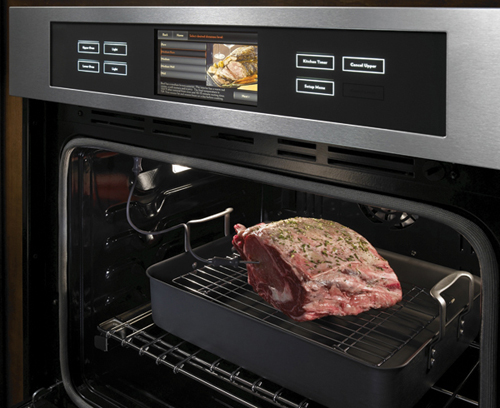Innovations in Smart, Universal, Energy-efficient and Water-saving Home Appliances
Cooking with pictures − wall ovens
While ovens are not currently qualified by the ENERGY STAR program there are still features that can provide energy-efficient baking for your kitchen. Early adopters, technology geeks and new cooks will want to know about this 21st century wall oven that includes a glass LCD touch screen that acts as a cook's assistant. By touching the screen to choose the food category, food type, desired doneness and type of pan, the thermal sensors, computer processors, and chef-tested cooking programs, will set the desired time and temperature for almost any meal. The resulting perfectly cooked meal, eliminates testing completeness by opening and closing the oven door .
Additional high tech features are also available that enhance the baking experience while reducing energy demands. Convection technology results in shorter, more energy efficient cooking because it provides an even heat throughout the oven. In addition new convection technology utilizing two fan speeds along with one or two high powered 3,400-watt convection elements create the power and sensitivity to roast large turkeys or bake delicate pastries with precision.
It is obvious to all that preheating an oven is a significant waste of energy. The use of high powered elements and dual-fans in convection ovens has resulted in no preheat and rapid preheat modes. Depending on the baking requirements and the technology preheating can be completely eliminated or as in the case of the Rapid Preheat mode reduced by up to 30 percent.
 |
This culinary center sets the temperature and cooking time for almost any meal utilizing computer logic and probe/sensor cooking. Photo: Jenn-Air® |
Â
Refrigerators
 |
ENERGY STAR qualified refrigerators can reduce energy bills by 20 percent. Photo: Maytag® |
Manufacturers have focused on improved refrigeration and more energy-efficient compressors, to create the newest ENERGY STAR qualified refrigerators. According to the U.S. Department of Energy, replacing a non-ENERGY STAR qualified refrigerator with one that is labeled with the ENERGY STAR logo will cut energy bills by 20 percent. To help your client realize maximum savings, you can use the ENERGY STAR savings calculator to find out the exact savings.8
In an average household, the refrigerator accounts for as much as 12 to 20 percent of total power used in one year. Features to look for in an energy-saving refrigerator include:
- Adaptive defrost control, which adjusts compressor time and prevents less freezing and unfreezing of food and conserves a significant amount of energy.
- Double tub construction and a foam-in-place door provides extra insulation and keep cold air from escaping the refrigerator compartments.
- Temperature-controlled bins and compartments that allow you to turn down the temperature in small spaces within the refrigerator, without lowering the temperature in the entire compartment.
For accessibility, and flexibility, professionals may want to consider choosing:
- Wide glass shelves that provide a large surface area.
- See -through bins.
- Adjustable shelves that maximize the reach to refrigerated objects for all users.
- Water dispensers within easy reach and that include filter status lights
In order to use less energy, the design professional can help the homeowner select a refrigerator of the appropriate size. Typically, the most energy-efficient refrigerators are between 16 and 20 cubic feet. According to ENERGY STAR, top-mounted freezers use 10 to 25 percent less energy than bottom-mount or side-by-side models. The design professional can find a list of ENERGY STAR refrigerators as well as other energy-efficient products on the ENERGY STAR website.9









